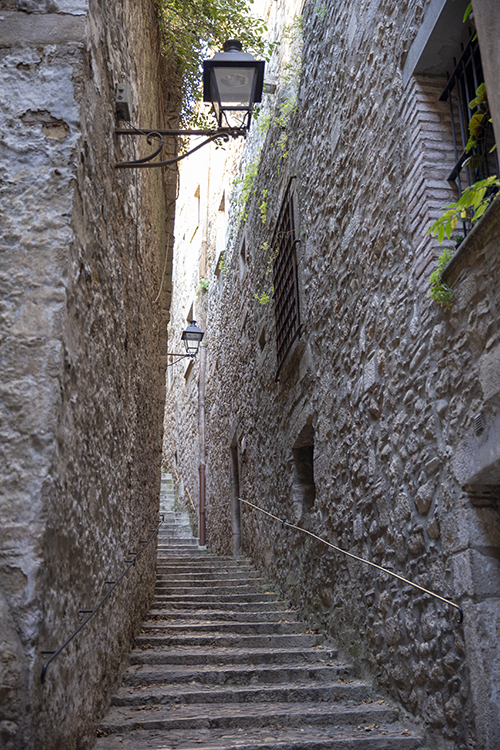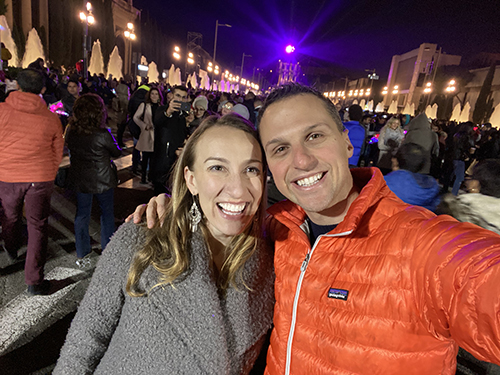








it's 40k kilometers around the world's circumference








Mixing things up one afternoon, we drive out to the Penedes area not far outside of Barcelona as we heard it’s Catalonia’s wine region. In particular, this region is famous for producing cava, Spain’s famous sparkling wine. We learn that 95% of all cava is actually produced here.
We aren’t too sure what to expect, and when we arrive we find a beautiful, sleepy, unassuming little town with a giant chocolate factory (we obviously spend some time here) and a bunch of wineries. The wineries in town look small but established – when walking around, we find that the wine tasting culture of northern California is very different from that in Penedes. There are only a couple other couples we run into also doing some touring and tasting; otherwise, it’s a very quiet afternoon.
There are two highlights of our visit: 1) we find a winery, Vilarnau, outside of town on a hill that we aren’t sure is even open, but once we walk in and start chatting with one of the workers, he keeps encouraging us to taste different wines and even gives us a tour of their wine cave. And 2) we take a tour of one of the wineries in town called Recaredo. We quickly learn that there are multiple levels of caves underground full of wine bottles of different vintages and in different stages of the fermentation process. When we come back out of the cave we find ourselves in an entirely different block of the town. A true a-ha moment comes when we put together that cava means “cave”.


We’re now feeling like we’ve really explored Catalonia. Along with finding many of the nooks and crannies in Barcelona, we’ve ventured up the coast to Girona and Figueres, westward and inland to Montserrat, and now it’s time for us to drive South down the coast. Our destination is Tarragona, a city founded in the 5th century BC, and now designated an UNESCO World Heritage Site due to its extensive Roman ruins.



But along the way, we find a surprise and beautiful stop. The inspiration for the stop is part because the car is low on gas, part because Lindsey needs to use the bathroom again, part because I’ve found a cute little coffee shop, and part because it’s halfway between Barcelona and Tarragona. Sitges, a small touristy beach town full of nice hotels, has a quaint old city and a pristine cathedral right on the ocean. Tarragona is spectacular as is expected, but Sitges turned out to be the real treat today.


On the return trip, we take the Catalonian equivalent of California’s Pacific Coast Highway and enjoy the colorful sky created by the sunset as we return to Barcelona.

One specific Christmas tradition leaves us a little confused, intrigued, and tickled all at once. Apparently, there exists in Catalan mythology a character named Tio Nadal. Tio for short is a log with a face on it often propped up by sticks like the picture below, which we photographed in a tapas bar.
Starting on December 8th with the Feast of the Immaculate Conception, kids feed the tio a little bit every night. Some even cover him with a blanket so he doesn’t get cold. Then, in the days preceding Christmas, kids must take better and better care of the log to make sure that it will poop, yes defecate, many presents on Christmas. Even stranger, to make it poop when the day comes, kids often beat the tio with sticks singing all sorts of hilarious songs. It’s their version of Santa.





We’re off on another day trip in our rental car. First stop: Girona. We heard good things, but we had no real idea of its history. First, there were the Romans, then the Visigoths, then the Moors, and then finally a Catalonian county starting in the 8th century. One part of the old city that was particularly interesting to us was the old Jewish Quarter. It may be the best-preserved Jewish quarter in all of Europe. A Jewish community had lived there until late 1400’s when the Catholic Monarchs gave Jews the choice to convert or leave. The other highlight of Girona for us is the churro guy – freshly deep-fried churros sprinkled with cinnamon and sugar makes for a wonderfully warm snack on a chilly morning.





Not far from Girona, we continue on to Figueres, birthplace and now resting place of Salvador Dali. There, Dali built a very eccentric museum to house much of his art. In his words: “I want my museum to be a single block, a labyrinth, a great surrealist object. It will be a totally theatrical museum. The people who come to see it will leave with the sensation of having had a theatrical dream.” We may have experienced that sensation, but we definitely left feeling that Dali was a weird, eccentric, egotistical artist. Quote from Lindsey: “this guy’s nuts!”

On a different day, but related because he’s another famous artist who spent some time in Catalonia, we visit the famous Picasso Museum in Barcelona. Along with enjoying one of the most extensive collections of his art anywhere in the world, we also enjoy learning a little more about him through listening to the fictional novel Cooking for Picasso in the car as we drive around Catalonia. The book really paints a picture (pun intended) of how the artist had many mistresses in addition to his wives. He was married twice and had four children by three women, or at least officially. The book may suggest otherwise :).

When the New Year arrives, the tradition is to eat twelve grapes synchronized exactly with the twelve dongs of the church bells. Turns out it’s a lot harder than it sounds and is very funny to take part in! They say you’ll be blessed with good luck the following year.
Taking a step back, we begin the night by exploring the equivalent of Barcelona’s time square where they have a midnight-dropping ball and all. We then venture to a festive tapas place called Paco Meralgo, where they turn the atmosphere into a bit of party come midnight handing out 12 grapes along with a goody bag of silly toys.
Happy New Year!




As part of our stay in Barcelona, we rent a car to explore some of the nearby sites. The first one on the list, Montserrat, surprises us in many ways. The first is weather – we’re completely submerged in a cloud until about 100m away from the Benedictine Abbey near the top of the mountain when we actually find ourselves above those clouds. We finally find parking, step outside our car, and realize we probably should’ve packed another layer. Luckily, we both had sweaters and warm jackets, but even that was barely enough as the temperatures were below freezing.
The second surprise was how much Catalonia history was packed into this small abbey. Serrat is in fact a Catalan word meaning “serrated”, which refers to the outline of the mountain we’ve climbed. And it is Catalonia’s most important religious location, first built in the 11th century and then again in the 20th. It is still functioning today.
The third surprise is when we learn of the artists featured in the connected museum, we hadn’t expected to find works by Caravaggio, Picasso, Dali, Monet, Degas, and many other greats!


This trip has been different from some of our other trips for lots of reasons, but one noticeable one is the pace. We call it babymoon pace. The naps are more frequent, the snacks and meals are a little longer, the walks are a bit mellower, and the bathroom breaks are constant. And although this is new for us, it is not unwelcome. We end up noticing more things, meeting more people, just simply absorbing more.
And come the afternoon when we’re not tired enough to nap or hungry enough to eat, and when the sun is going down so strolling endlessly through the winding streets becomes a little less appealing, it’s cribbage time. It’s a nice mix of luck and skill, so even in the heat of competition, it’s also possible to claim bad luck. And when we run out of things to say, we can just count aloud our scores… fifteen two fifteen four and pair for six.
So we find ourselves a nice café or rooftop, take out cribbage, order some cava and mocktails, and just enjoy each other’s company over a semi-competitive game.





Onwards to Barcelona. We start our time in Barcelona by learning about its history through architecture. At the time of the Industrial Revolution, Barcelona really takes off, and as part of the expansion created by the rush of people to cities, Modernist architects such as Antoni Gaudi get their chance to shine. Our guided tour throughout the city helps us appreciate these unique and beautiful buildings.




One building in particular, the Sagrada Familia, was very impressive not only in its grandeur, sculpture, stained-glass windows, attention to detail, but also for the fact that it began in the late 1800s and is still being built today. During these 150 years, there was one major hiccup in 1936 during the Spanish Civil War when Gaudi’s original plans, drawings and models were all destroyed. Although Gaudi had already passed away, many of the other architects and builders were able to at least piece most of his original vision back together. But many believe that Gaudi would have also fully approved of the building evolving over time as long as the original intent and vision remains intact.



I had the chance to visit this basilica back in 2010 and it was incredible to see the progress that has been made since. In the pictures below, I’ve included the old next to the new to appreciate how much grander the site has become. And now, our guide was saying that the Sagrada is predicted to be completed by 2026 to mark the 100 year anniversary of Gaudi’s death. Although there’s still about 25% of the work remaining, because of new technologies plus an influx in funding from all of the ticket sales of visitors coming to witness the site, it may only be another 6 years.

